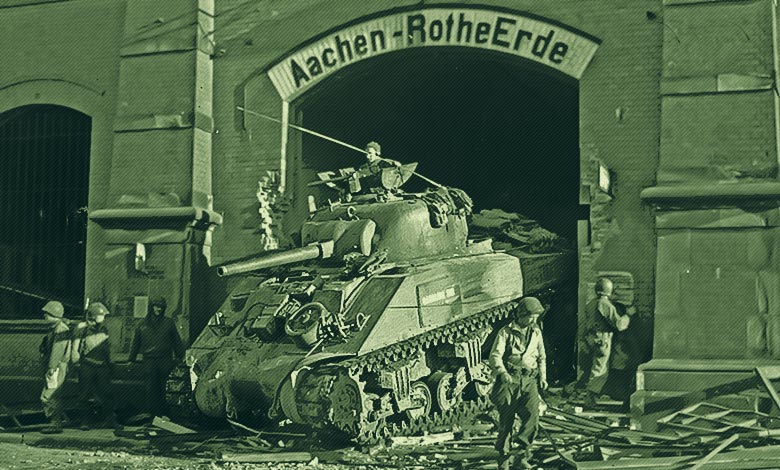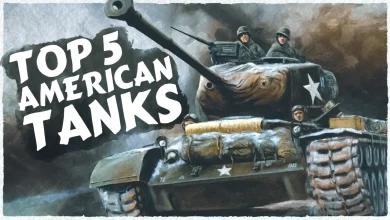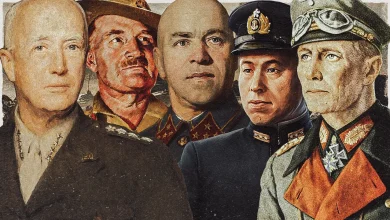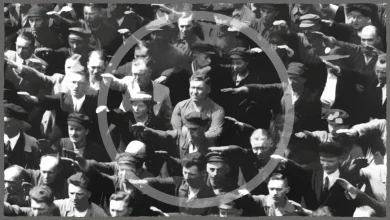Battle of Aachen – First German City to Fall in WW2

Following D-Day and the Battle of Normandy in the summer of 1944. The German Army in the West collapsed and retreated towards the defenses of the Westwall, known more popularly in the West as the Siegfried Line.

The Allied armies followed hot on their heels, hoping to break into western Germany in autumn 1944 and finish the war early. But Allied fuel and supply problems ground the British, American, Canadian, and French armies to a halt, providing the Germans with precious time to reorganize their defenses and bring up reinforcements.
By late September 1944, the Germans had 230.000 troops along with the Siegfried Line defenses and 500 tanks and assault guns. They would make the Allies fight for every yard of territory to keep them out of Germany’s industrial heartlands, the Ruhr and Saar regions.

In the main U.S. area of operations, General George S. Patton’s U.S. Third Army was tasked with capturing the German-occupied French region of Lorraine on the border with Germany. While General Courtney Hodges U.S. 1st Army would push through the German front of the city of Aachen and race for the Rhine River.
The city of Aachen was not militarily important rather it was symbolic. It was the first German city to be in reach of allied ground forces and was the historic capital of Emperor Charlemagne’s 1st Reich and a very stiff fight was expected for Aachen.
Aachen was well protected by a 10 mile deep Siegfried Line defense system consisting of pillboxes, barbed wire, bunkers, minefields, and Dragon’s Teeth anti-tank obstacles.


Fighting broke out in the second week of September. Aachen was defended by the 116th Panzer Division at that time, his commander General Gerhard von Schwerin demanded that the city’s population be evacuated to safety, this was not done.
Most Nazi city officials had however already fled. Von Schwerin actually tried to surrender the city to the Americans. He wanted to spare the civil population from death and destruction but Hitler ordered his arrest before this could happen.

A new commandant Colonel Gerhard Wilck was ordered to fight to the last. U.S. forces of the 1st Infantry Division probed the defenses but supply problems slowed them down. Defense of the city and the area around it with a responsibility of some 20,000 Germans and 11 tanks from a variety of units rushed into the area. In October more reinforcements arrived, including elements of the 1st SS Panzer Division Leibstandarte SS Adolf Hitler. But many of the ordinary German units were heavily under strength and using poorly trained troops.
Major General Charles H. Corlett’s XIX Corps was assigned to take the city. Consisting of two infantry and one armored division, plus heavy flank protection from other U.S. Corps. The Americans intended to surround the city of Aachen then use a small force to actually capture the city center itself. For six days before the assault, U.S. artillery and aircraft targeted German defenses around Aachen to little effect.
The next phase was the slowed reduction of Aachen’s outer defenses, taking heavily defended towns and villages and pillbox lines. More German divisions and units were transferred in to help the defense of the city. Though taking heavy casualties U.S. forces eventually met on the 16th of October 1944 surrounding the city of Aachen. U.S. casualties thus far were 400 dead and 2,000 wounded. Germans had lost 630 killed and 4,400 wounded.

Fighting off constant German counter-attacks on the perimeter the U.S. forces now had to deal with the city of Aachen itself. Only a single infantry regiment of just two battalions, the 26th Infantry would try to capture it.

Aachen was defended by a motley collection of about 5000 German troops including Navy Air Force and police. They had only a handful of tanks and assault guns to help them but the city center was a maze of narrow streets and alleyways, medieval buildings, and huge walls, perfect for defense. On the 13th of October, the 26th Infantry attacked.

They were ambushed by German troops using the sewer system and cellars to move around. U.S. armor had difficulty maneuvering in the streets and they were easily picked off by German Panzerfaust rocket projectors and hidden anti-tank guns. The advance was made house by house almost room by room, a 155 mm Howitzer was used as well as U.S. armor, firing point-blank at walls to knock out German strong points.

U.S. infantry began to advance house-to-house, avoiding the streets that were swept by German fire. Sherman’s were ambushed constantly. The damage caused to the city was immense with many historic buildings being destroyed. German infantry launched constant local counter-attacks and used their handful of tanks to good effect.

By the 18th of October one of the last major buildings in German hands was the hotel Quellenhof, the German defense headquarters, held by many troops and at least 300 SS. The defenders managed to beat off several U.S. assaults and even counter-attack overrunning nearby U.S. positions until themselves beat off by heavy mortar fire.
The Americans decided that in order to reduce U.S. casualties 155 mm guns would be used to pound German strong points to pieces. This way buildings were simply knocked down with the defenders inside of them. Another infantry battalion was sent in to assist the 26th Infantry.
On the 21st of October 1944, the U.S. forces managed to take the center of Aachen and the surviving German garrison at the hotel surrendered. The U.S. victory came with 5,000 casualties, the Germans also suffered about 5,000 casualties with a further 5,600 taken prisoner. The fierce German resistance at Aachen upset Allied plans to continue their advance eastwards. The U.S. 1st Army was then assigned to the capture of the important Ruhr Dams behind the Hürtgen Forest, which would lead to a bigger and far nastier fight than that for Aachen.

But the important point was that the Americans had pierced the Siegfried Line and were beginning their inexorable advance towards the Rhine, Germany’s symbolic final Western barrier.



